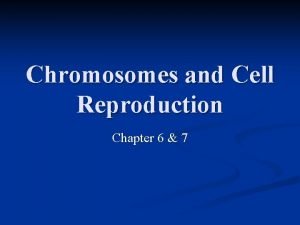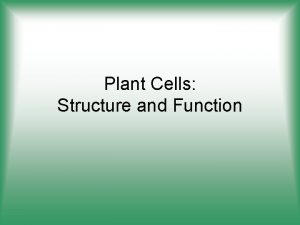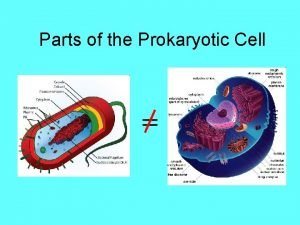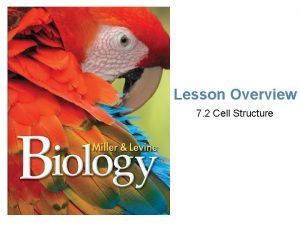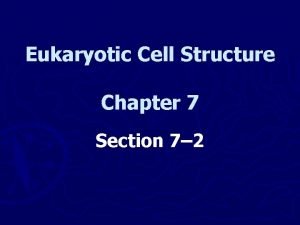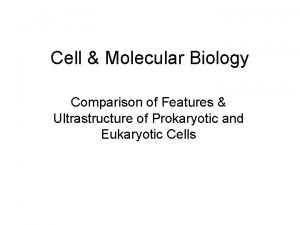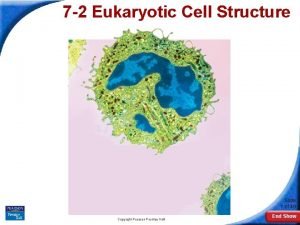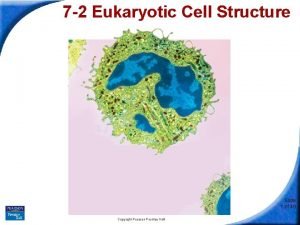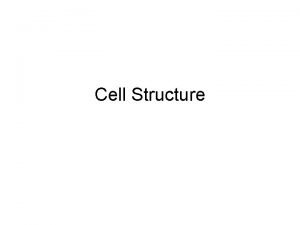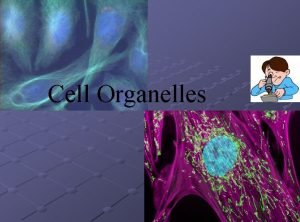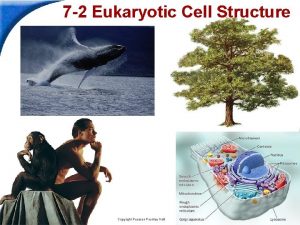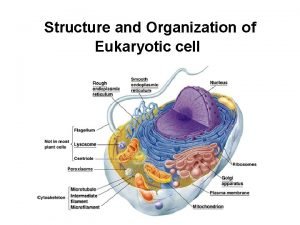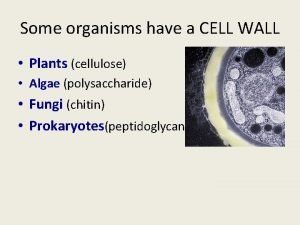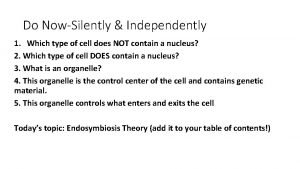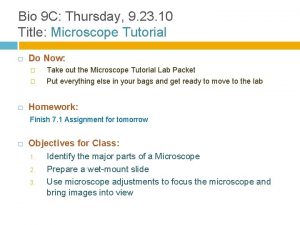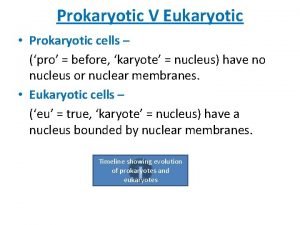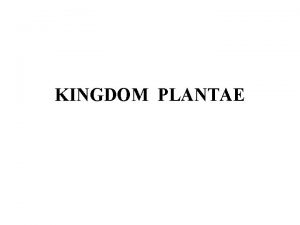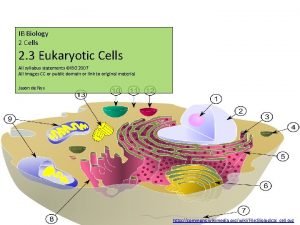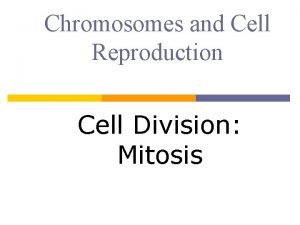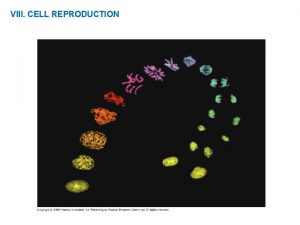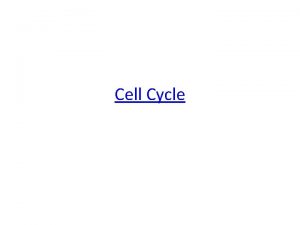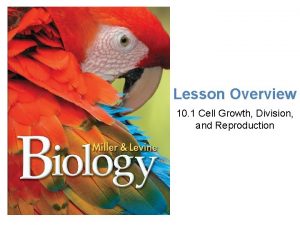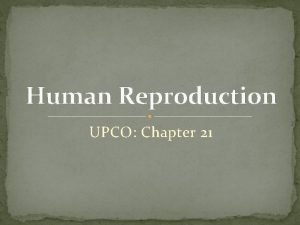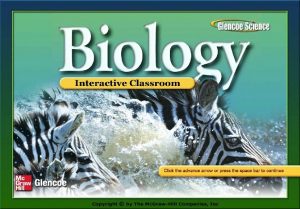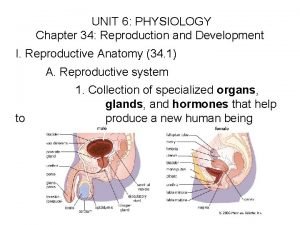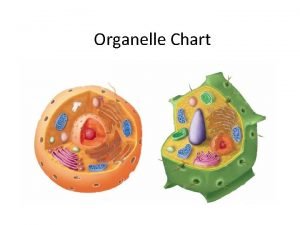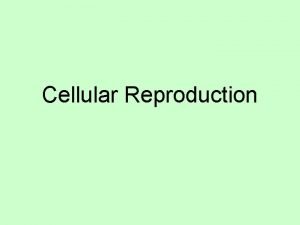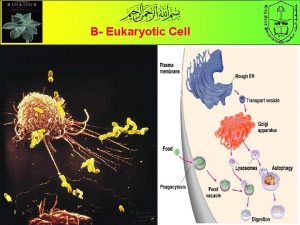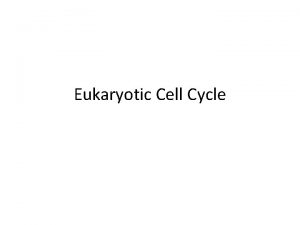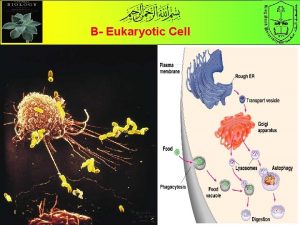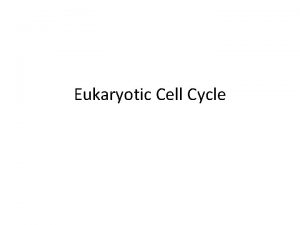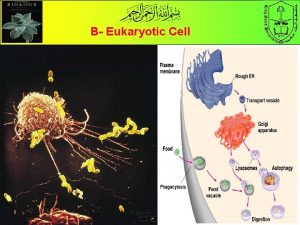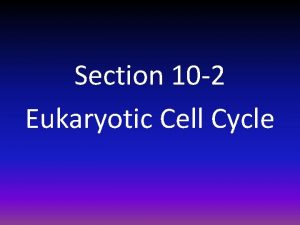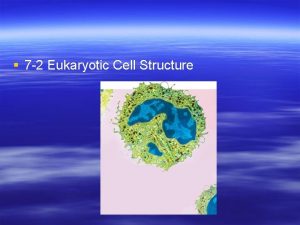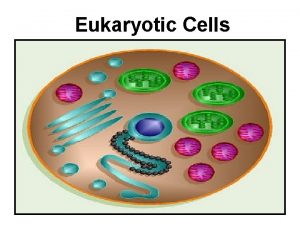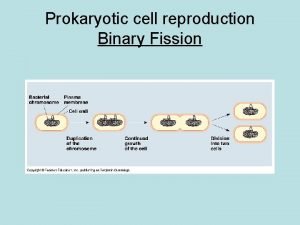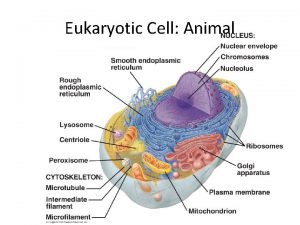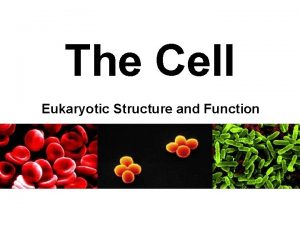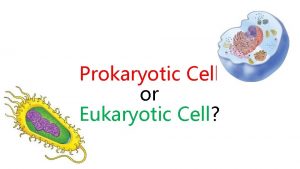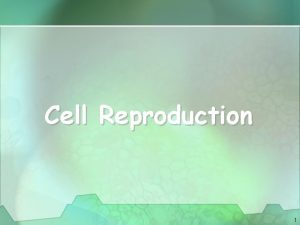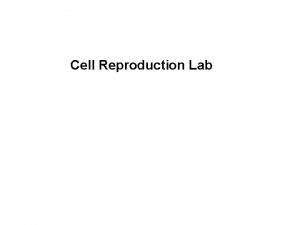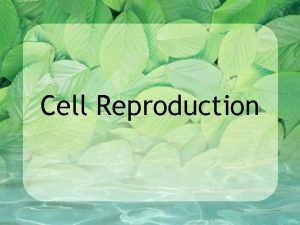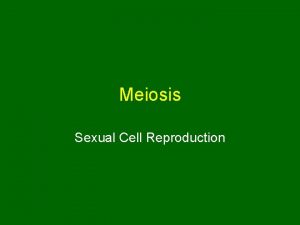Chapter IV Part 2 Reproduction of EUKARYOTIC cell






















































- Slides: 54

Chapter IV Part 2 Reproduction of EUKARYOTIC cell By Pn. Aslizah Binti Mohd Aris 06 -4832168

Overview: Variations on a Theme Living organisms are distinguished by their ability to reproduce their own kind • Genetics is the scientific study of heredity and variation • Heredity is the transmission of traits from one generation to the next • Variation is demonstrated by the differences in appearance that offspring show from parents and siblings • Copyright © 2008 Pearson Education Inc. , publishing as Pearson Benjamin Cummings

Fig. 13 -1

Comparison of Asexual and Sexual Reproduction In asexual reproduction, one parent produces genetically identical offspring by mitosis • A clone is a group of genetically identical individuals from the same parent • In sexual reproduction, two parents give rise to offspring that have unique combinations of genes inherited from the two parents • Video: Hydra Budding Copyright © 2008 Pearson Education Inc. , publishing as Pearson Benjamin Cummings

Fig. 13 -2 0. 5 mm Parent Bud (a) Hydra (b) Redwoods

Sets of Chromosomes in Human Cells • Human somatic cells (any cell other than a gamete) have 23 pairs of chromosomes • A karyotype is an ordered display of the pairs of chromosomes from a cell • The two chromosomes in each pair are called homologous chromosomes, or homologs • Chromosomes in a homologous pair are the same length and carry genes controlling the same inherited characters Copyright © 2008 Pearson Education Inc. , publishing as Pearson Benjamin Cummings

Fig. 13 -3 APPLICATION TECHNIQUE 5 µm Pair of homologous replicated chromosomes Centromere Sister chromatids Metaphase chromosome

The sex chromosomes are called X and Y Human females have a homologous pair of X chromosomes (XX) • Human males have one X and one Y chromosome • The 22 pairs of chromosomes that do not determine sex are called autosomes • • Copyright © 2008 Pearson Education Inc. , publishing as Pearson Benjamin Cummings

Each pair of homologous chromosomes includes one chromosome from each parent • The 46 chromosomes in a human somatic cell are two sets of 23: one from the mother and one from the father • A diploid cell (2 n) has two sets of chromosomes • For humans, the diploid number is 46 (2 n = 46) • Copyright © 2008 Pearson Education Inc. , publishing as Pearson Benjamin Cummings

Fig. 13 -4 Key 2 n = 6 Maternal set of chromosomes (n = 3) Paternal set of chromosomes (n = 3) Two sister chromatids of one replicated chromosome Two nonsister chromatids in a homologous pair Centromere Pair of homologous chromosomes (one from each set)

• • • A gamete (sperm or egg) contains a single set of chromosomes, and is haploid (n) For humans, the haploid number is 23 (n = 23) Each set of 23 consists of 22 autosomes and a single sex chromosome In an unfertilized egg (ovum), the sex chromosome is X In a sperm cell, the sex chromosome may be either X or Y Copyright © 2008 Pearson Education Inc. , publishing as Pearson Benjamin Cummings

Behavior of Chromosome Sets in the Human Life Cycle Fertilization is the union of gametes (the sperm and the egg) • The fertilized egg is called a zygote and has one set of chromosomes from each parent • The zygote produces somatic cells by mitosis and develops into an adult • Copyright © 2008 Pearson Education Inc. , publishing as Pearson Benjamin Cummings

At sexual maturity, the ovaries and testes produce haploid gametes • Gametes are the only types of human cells produced by meiosis, rather than mitosis • Meiosis results in one set of chromosomes in each gamete • Fertilization and meiosis alternate in sexual life cycles to maintain chromosome number • Copyright © 2008 Pearson Education Inc. , publishing as Pearson Benjamin Cummings

Fig. 13 -5 Key Haploid gametes (n = 23) Haploid (n) Egg (n) Diploid (2 n) Sperm (n) MEIOSIS Ovary FERTILIZATION Testis Diploid zygote (2 n = 46) Mitosis and development Multicellular diploid adults (2 n = 46)

The Variety of Sexual Life Cycles The alternation of meiosis and fertilization is common to all organisms that reproduce sexually • The three main types of sexual life cycles differ in the timing of meiosis and fertilization • Copyright © 2008 Pearson Education Inc. , publishing as Pearson Benjamin Cummings

In animals, meiosis produces gametes, which undergo no further cell division before fertilization • Gametes are the only haploid cells in animals • Gametes fuse to form a diploid zygote that divides by mitosis to develop into a multicellular organism • Copyright © 2008 Pearson Education Inc. , publishing as Pearson Benjamin Cummings

Fig. 13 -6 Key Haploid (n) n Gametes n Mitosis n n MEIOSIS FERTILIZATION Diploid multicellular organism (a) Animals Zygote 2 n Mitosis n Spores Mitosis n n n MEIOSIS 2 n Haploid unicellular or multicellular organism Haploid multicellular organism (gametophyte) Diploid (2 n) Gametes Mitosis n n Gametes FERTILIZATION MEIOSIS 2 n Diploid multicellular organism (sporophyte) n 2 n Mitosis (b) Plants and some algae Zygote FERTILIZATION 2 n Zygote (c) Most fungi and some protists

Meiosis reduces the number of chromosome sets from diploid to haploid Like mitosis, meiosis is preceded by the replication of chromosomes • Meiosis takes place in two sets of cell divisions, called meiosis I and meiosis II • The two cell divisions result in four daughter cells, rather than the two daughter cells in mitosis • Each daughter cell has only half as many chromosomes as the parent cell • Copyright © 2008 Pearson Education Inc. , publishing as Pearson Benjamin Cummings

The Stages of Meiosis In the first cell division (meiosis I), homologous chromosomes separate • Meiosis I results in two haploid daughter cells with replicated chromosomes; it is called the reductional division • In the second cell division (meiosis II), sister chromatids separate • Meiosis II results in four haploid daughter cells with unreplicated chromosomes; it is called the equational division • Copyright © 2008 Pearson Education Inc. , publishing as Pearson Benjamin Cummings

Fig. 13 -7 -3 Interphase Homologous pair of chromosomes in diploid parent cell Chromosomes replicate Homologous pair of replicated chromosomes Sister chromatids Diploid cell with replicated chromosomes Meiosis I 1 Homologous chromosomes separate Haploid cells with replicated chromosomes Meiosis II 2 Sister chromatids separate Haploid cells with unreplicated chromosomes

Meiosis I is preceded by interphase, in which chromosomes are replicated to form sister chromatids • The sister chromatids are genetically identical and joined at the centromere • The single centrosome replicates, forming two centrosomes • Bio. Flix: Meiosis Copyright © 2008 Pearson Education Inc. , publishing as Pearson Benjamin Cummings

Fig. 13 -8 Metaphase I Prophase I Centrosome (with centriole pair) Sister chromatids Chiasmata Spindle Centromere (with kinetochore) Prophase II Metaphase II Anaphase II Telophase II and Cytokinesis Sister chromatids remain attached Metaphase plate Homologous chromosomes separate Homologous chromosomes Fragments of nuclear envelope Telophase I and Cytokinesis Anaphase I Microtubule attached to kinetochore Cleavage furrow Sister chromatids separate Haploid daughter cells forming

• Division in meiosis I occurs in four phases: – Prophase I – Metaphase I – Anaphase I – Telophase I and cytokinesis Copyright © 2008 Pearson Education Inc. , publishing as Pearson Benjamin Cummings

Fig. 13 -8 a Prophase I Metaphase I Centrosome (with centriole pair) Sister chromatids Centromere (with kinetochore) Chiasmata Spindle Metaphase plate Sister chromatids remain attached Homologous chromosomes separate Homologous chromosomes Fragments of nuclear envelope Microtubule attached to kinetochore Telophase I and Cytokinesis Anaphase I Cleavage furrow

Prophase I typically occupies more than 90% of the time required for meiosis • Chromosomes begin to condense • In synapsis, homologous chromosomes loosely pair up, aligned gene by gene • Copyright © 2008 Pearson Education Inc. , publishing as Pearson Benjamin Cummings

In crossing over, nonsister chromatids exchange DNA segments • Each pair of chromosomes forms a tetrad, a group of four chromatids • Each tetrad usually has one or more chiasmata, X-shaped regions where crossing over occurred • Copyright © 2008 Pearson Education Inc. , publishing as Pearson Benjamin Cummings

Metaphase I • In metaphase I, tetrads line up at the metaphase plate, with one chromosome facing each pole • Microtubules from one pole are attached to the kinetochore of one chromosome of each tetrad • Microtubules from the other pole are attached to the kinetochore of the other chromosome Copyright © 2008 Pearson Education Inc. , publishing as Pearson Benjamin Cummings

Fig. 13 -8 b Prophase I Metaphase I Centrosome (with centriole pair) Sister chromatids Chiasmata Spindle Centromere (with kinetochore) Metaphase plate Homologous chromosomes Fragments of nuclear envelope Microtubule attached to kinetochore

Anaphase I In anaphase I, pairs of homologous chromosomes separate • One chromosome moves toward each pole, guided by the spindle apparatus • Sister chromatids remain attached at the centromere and move as one unit toward the pole • Copyright © 2008 Pearson Education Inc. , publishing as Pearson Benjamin Cummings

Telophase I and Cytokinesis In the beginning of telophase I, each half of the cell has a haploid set of chromosomes; each chromosome still consists of two sister chromatids • Cytokinesis usually occurs simultaneously, forming two haploid daughter cells • Copyright © 2008 Pearson Education Inc. , publishing as Pearson Benjamin Cummings

In animal cells, a cleavage furrow forms; in plant cells, a cell plate forms • No chromosome replication occurs between the end of meiosis I and the beginning of meiosis II because the chromosomes are already replicated • Copyright © 2008 Pearson Education Inc. , publishing as Pearson Benjamin Cummings

Fig. 13 -8 c Telophase I and Cytokinesis Anaphase I Sister chromatids remain attached Homologous chromosomes separate Cleavage furrow

Meiosis II • Division in meiosis II also occurs in four phases: – Prophase II – Metaphase II – Anaphase II – Telophase II and cytokinesis • Meiosis II is very similar to mitosis Copyright © 2008 Pearson Education Inc. , publishing as Pearson Benjamin Cummings

Fig. 13 -8 d Prophase II Metaphase II Anaphase II Telophase II and Cytokinesis Sister chromatids separate Haploid daughter cells forming

Prophase II • • In prophase II, a spindle apparatus forms In late prophase II, chromosomes (each still composed of two chromatids) move toward the metaphase plate Copyright © 2008 Pearson Education Inc. , publishing as Pearson Benjamin Cummings

Metaphase II In metaphase II, the sister chromatids are arranged at the metaphase plate • Because of crossing over in meiosis I, the two sister chromatids of each chromosome are no longer genetically identical • The kinetochores of sister chromatids attach to microtubules extending from opposite poles • Copyright © 2008 Pearson Education Inc. , publishing as Pearson Benjamin Cummings

Fig. 13 -8 e Prophase II Metaphase II

Anaphase II In anaphase II, the sister chromatids separate • The sister chromatids of each chromosome now move as two newly individual chromosomes toward opposite poles • Copyright © 2008 Pearson Education Inc. , publishing as Pearson Benjamin Cummings

Telophase II and Cytokinesis In telophase II, the chromosomes arrive at opposite poles • Nuclei form, and the chromosomes begin decondensing • Copyright © 2008 Pearson Education Inc. , publishing as Pearson Benjamin Cummings

Cytokinesis separates the cytoplasm At the end of meiosis, there are four daughter cells, each with a haploid set of unreplicated chromosomes • Each daughter cell is genetically distinct from the others and from the parent cell • • Copyright © 2008 Pearson Education Inc. , publishing as Pearson Benjamin Cummings

Fig. 13 -8 f Anaphase II Telephase II and Cytokinesis Sister chromatids separate Haploid daughter cells forming

A Comparison of Mitosis and Meiosis Mitosis conserves the number of chromosome sets, producing cells that are genetically identical to the parent cell • Meiosis reduces the number of chromosomes sets from two (diploid) to one (haploid), producing cells that differ genetically from each other and from the parent cell • The mechanism for separating sister chromatids is virtually identical in meiosis II and mitosis • Copyright © 2008 Pearson Education Inc. , publishing as Pearson Benjamin Cummings

Fig. 13 -9 MITOSIS MEIOSIS Parent cell Chromosome replication Prophase Chiasma Chromosome replication Prophase I Homologous chromosome pair 2 n = 6 Replicated chromosome MEIOSIS I Metaphase I Anaphase Telophase Anaphase I Telophase I Haploid n=3 Daughter cells of meiosis I 2 n MEIOSIS II 2 n Daughter cells of mitosis n n Daughter cells of meiosis II SUMMARY Property Mitosis Meiosis DNA replication Occurs during interphase before mitosis begins Occurs during interphase before meiosis I begins Number of divisions One, including prophase, metaphase, anahase, and telophase Two, each including prophase, metaphase, and telophase Synapsis of homologous chromosomes Does not occur Occurs during prophase I along with crossing over between nonsister chromatids; resulting chiasmata hold pairs together due to sister chromatid cohesion Number of daughter cells and genetic composition Two, each diploid (2 n) and genetically identical to the parent cell Four, each haploid (n), containing half as many chromosomes as the parent cell; genetically different from the parent cell and from each other Role in the animal body Enables multicellular adult to arise from zygote; produces cells for growth, repair, and, in some species, asexual reproduction Produces gametes; reduces number of chromosomes by half and introduces genetic variability amoung the gametes

You should now be able to: Distinguish between the following terms: somatic cell and gamete; autosome and sex chromosomes; haploid and diploid 2. Describe the events that characterize each phase of meiosis 3. Describe three events that occur during meiosis I but not mitosis 1. Copyright © 2008 Pearson Education Inc. , publishing as Pearson Benjamin Cummings

The timing and pattern of meiosis in mammals differ for males and females �Gametogenesis, the production of gametes by meiosis, differs in females and males �Sperm are small and motile and are produced throughout the life of a sexually mature male �Spermatogenesis is production of mature sperm

Spermatogenesis and oogenesis in an animal cell

Spermatogenesis In diploid animals, the only haploid cells are gametes produced by meiosis and used in sexual reproduction. Gametes are produced by specialized cells. In males, spermatogenesis produces spermatozoa within the testes. Primordial germ cells (primary spermatogonia) undergo mitosis to produce secondary spermatogonia. Secondary spermatogonia transform into primary spermatocytes (meiocytes), which undergo meiosis I, giving rise to two secondary spermatocytes. Each secondary spermatocyte undergoes meiosis II, producing haploid spermatids that differentiate into spermatozoa.

Fig. 46 -12 a Epididymis Seminiferous tubule Testis Cross section of seminiferous tubule Primordial germ cell in embryo Mitotic divisions Sertoli cell nucleus Spermatogonial stem cell 2 n Mitotic divisions Spermatogonium 2 n Mitotic divisions Primary spermatocyte 2 n Meiosis I Lumen of seminiferous tubule Secondary spermatocyte n n Meiosis II Neck Tail Midpiece Head Spermatids (at two stages of differentiation) Early spermatid n n n Differentiation (Sertoli cells provide nutrients) Plasma membrane Mitochondria Sperm Nucleus Acrosome n n

Fig. 46 -12 c Primordial germ cell in embryo Mitotic divisions Spermatogonial stem cell 2 n Mitotic divisions Spermatogonium 2 n Mitotic divisions Primary spermatocyte 2 n Meiosis I Secondary spermatocyte n n Meiosis II Early spermatid n n n Differentiation (Sertoli cells provide nutrients) Sperm n n

Oogenesis In females, oogenesis produces eggs (oocytes) in the ovary. (1) Primordial germ cells (primary oogonia) undergo mitosis to produce secondary oogonia. (2) Secondary oogonia transform into primary oocytes, which grow until the end of oogenesis. (3) Primary oocytes undergo meiosis I and unequal cytokinesis, producing a large secondary oocyte, and a small cell called the first polar body. (4) The secondary oocyte produces two haploid cells in meiosis II. One is a very small cell, the second polar body, and the other rapidly matures into an ovum. (5) The first polar body may or may not divide during meiosis I. Polar bodies have no function in most species and degenerate, so that a round of meiosis produces only one viable gamete, the ovum. Human oocytes form in the fetus, completing meiosis only after fertilization.

Oogenesis �Eggs contain stored nutrients and are much larger �Oogenesis is development of mature oocytes (eggs) and can take many years

Fig. 46 -12 e Ovary Primary oocyte within follicle In embryo Growing follicle Primordial germ cell Mitotic divisions 2 n Oogonium Mitotic divisions Primary oocyte (present at birth), arrested in prophase of meiosis I 2 n Completion of meiosis I and onset of meiosis II First polar n body n Secondary oocyte, arrested at metaphase of meiosis II Ovulation, sperm entry Mature follicle Ruptured follicle Ovulated secondary oocyte Completion of meiosis II Second polar n body Corpus luteum n Fertilized egg Degenerating corpus luteum

Fig. 46 -12 g In embryo Primordial germ cell Mitotic divisions 2 n Oogonium Mitotic divisions Primary oocyte (present at birth), arrested in prophase of meiosis I 2 n First polar body Completion of meiosis I and onset of meiosis II n n Secondary oocyte, arrested at metaphase of meiosis II Ovulation, sperm entry Completion of meiosis II Second polar n body n Fertilized egg

• Spermatogenesis differs from oogenesis: In oogenesis, one egg forms from each cycle of meiosis; in spermatogenesis four sperm form from each cycle of meiosis Oogenesis ceases later in life in females; spermatogenesis continues throughout the adult life of males Oogenesis has long interruptions; spermatogenesis produces sperm from precursor cells in a continuous sequence
 Prokaryotic vs eukaryotic cell
Prokaryotic vs eukaryotic cell Prokaryotic
Prokaryotic Prokaryotic cell and eukaryotic cell
Prokaryotic cell and eukaryotic cell Eukaryotic cell animal cell
Eukaryotic cell animal cell Ghonarea
Ghonarea Sexual and asexual reproduction venn diagram
Sexual and asexual reproduction venn diagram Asexualk
Asexualk Sexual asexual venn diagram
Sexual asexual venn diagram Chapter 6 chromosomes and cell reproduction
Chapter 6 chromosomes and cell reproduction Eukaryotic plant
Eukaryotic plant Amoeba prokaryotic or eukaryotic
Amoeba prokaryotic or eukaryotic Cell structure
Cell structure Saclike structure that stores materials
Saclike structure that stores materials Eukaryotic cell structure
Eukaryotic cell structure Typical eukaryotic cell
Typical eukaryotic cell Section 7-2 eukaryotic cell structure
Section 7-2 eukaryotic cell structure Section 7-2 eukaryotic cell structure
Section 7-2 eukaryotic cell structure Eukaryotic cell organisation
Eukaryotic cell organisation Eukaryotic cell
Eukaryotic cell Eukaryotic cell structure
Eukaryotic cell structure Eukaryotic cells
Eukaryotic cells Dialysis membrane
Dialysis membrane Are cell walls prokaryotic or eukaryotic
Are cell walls prokaryotic or eukaryotic Do seedless plants have cell walls made of cellulose
Do seedless plants have cell walls made of cellulose Eukaryotic cell questions
Eukaryotic cell questions Eukaryotic cell with labels
Eukaryotic cell with labels Karyote
Karyote Eukaryotic cell
Eukaryotic cell Ib biology eukaryotic cell diagram
Ib biology eukaryotic cell diagram Are red blood cells prokaryotic
Are red blood cells prokaryotic Cell reproduction
Cell reproduction Sexual and asexual reproduction
Sexual and asexual reproduction Cell cycle and replication
Cell cycle and replication Cell reproduction
Cell reproduction Cell growth division and reproduction
Cell growth division and reproduction The scientist mathias schleiden studied _______ in ______.
The scientist mathias schleiden studied _______ in ______. Sexual reproduction
Sexual reproduction Pedigree miscarriage symbol
Pedigree miscarriage symbol Reproduction in human
Reproduction in human Chapter 9 section 1 cellular growth
Chapter 9 section 1 cellular growth Lesson 20.2 the male reproductive system
Lesson 20.2 the male reproductive system Chapter 19 asexual reproduction
Chapter 19 asexual reproduction Chapter 10 sexual reproduction and genetics
Chapter 10 sexual reproduction and genetics Section 1 cellular growth
Section 1 cellular growth Chapter 34 reproduction and development answer key
Chapter 34 reproduction and development answer key Chapter 9 cellular reproduction
Chapter 9 cellular reproduction Chapter 8 cellular reproduction cells from cells
Chapter 8 cellular reproduction cells from cells Part part whole addition
Part part whole addition Unit ratio definition
Unit ratio definition Brainpop ratios
Brainpop ratios What is technical description
What is technical description Parts of the front bar
Parts of the front bar The part of a shadow surrounding the darkest part
The part of a shadow surrounding the darkest part Minitab adalah
Minitab adalah Vacuole fun fact
Vacuole fun fact








